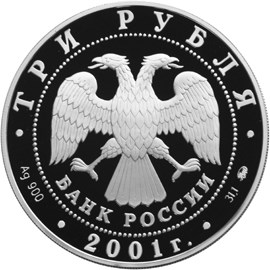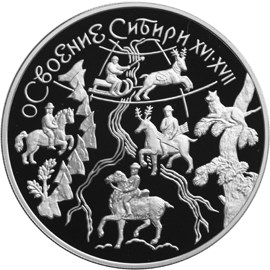The Development and Exploration of Siberia, the XVIth-XVIIth centuries
Obverse
in the center — the Emblem of the Bank of Russia [the two-headed eagle with wings down, lower — the semicircular inscription — «БАНК РОССИИ» (BANK OF RUSSIA)] framed by a circle of dots and inscriptions along the rim: at the top — «ТРИ РУБЛЯ» (THREE RUBLES), at the bottom — the year of issue «2001», the letters to the left indicate the metal sign and the fineness, to the right — the fine metal content and the mint trade mark.
Reverse
the map of Siberia from the XVIIth century: in the center — a river with a tributary, to the left — a rider on horseback, before him — a stylized mountain range, to the right — a rider on a deer holding a quiver with arrows, at the top — a driver guiding a sledge with a harnessed deer, at the bottom a rider on a Bactrian camel; to the right — a sable sitting on a tree. The inscription at the top along the rim: «ОСВОЕНИЕ СИБИРИ XVI·XVII» (THE DEVELOPMENT OF SIBERIA XVI·XVII).
Authors
The artist: A.V. Baklanov.
The sculptor: A.S. Khazov.
Moscow Mint (ММД).
The edge: 300 corrugations.
The settling of Siberia goes back to the Stone Age. In the first thousand years A.D. the peoples of Turcic Kaganat lived in southern regions of Siberia. In the XIIIth century a part of Siberia was in the Golden Horde and then in the Tyumeny and Siberian Khanats.


